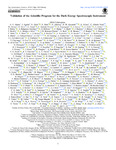Validation of the Scientific Program for the Dark Energy Spectroscopic Instrument

Use este enlace para citar
http://hdl.handle.net/2183/37517Colecciones
- Investigación (FIC) [1685]
Metadatos
Mostrar el registro completo del ítemTítulo
Validation of the Scientific Program for the Dark Energy Spectroscopic InstrumentFecha
2024-01-15Cita bibliográfica
Adame, A. G., Aguilar, J., Ahlen, S., Alam, S., Aldering, G., Alexander, D. M., ... & Leauthaud, A. (2024). Validation of the scientific program for the Dark Energy Spectroscopic Instrument. The Astronomical Journal, 167(2), 62. DOI 10.3847/1538-3881/ad0b08
Resumen
[Abstract]: The Dark Energy Spectroscopic Instrument (DESI) was designed to conduct a survey covering 14,000 deg2 over 5 yr to constrain the cosmic expansion history through precise measurements of baryon acoustic oscillations (BAO). The scientific program for DESI was evaluated during a 5 month survey validation (SV) campaign before beginning full operations. This program produced deep spectra of tens of thousands of objects from each of the stellar Milky Way Survey (MWS), Bright Galaxy Survey (BGS), luminous red galaxy (LRG), emission line galaxy (ELG), and quasar target classes. These SV spectra were used to optimize redshift distributions, characterize exposure times, determine calibration procedures, and assess observational overheads for the 5 yr program. In this paper, we present the final target selection algorithms, redshift distributions, and projected cosmology constraints resulting from those studies. We also present a One-Percent Survey conducted at the conclusion of SV covering 140 deg2 using the final target selection algorithms with exposures of a depth typical of the main survey. The SV indicates that DESI will be able to complete the full 14,000 deg2 program with spectroscopically confirmed targets from the MWS, BGS, LRG, ELG, and quasar programs with total sample sizes of 7.2, 13.8, 7.46, 15.7, and 2.87 million, respectively. These samples will allow exploration of the Milky Way halo, clustering on all scales, and BAO measurements with a statistical precision of 0.28% over the redshift interval z < 1.1, 0.39% over the redshift interval 1.1 < z < 1.9, and 0.46% over the redshift interval 1.9 < z < 3.5.
Palabras clave
Cosmology
Redshift surveys
Dark Energy Spectroscopic Instrument (DESI)
Redshift surveys
Dark Energy Spectroscopic Instrument (DESI)
Descripción
Data Availability
The Data Release 9 of the DESI Legacy Imaging Surveys is available at https://legacysurvey.org/dr9/.
Documentation of DESI data access is maintained at https://data.desi.lbl.gov/doc/access/.
All data points used in published graphs are available in Zenodo: doi: [doi:10.5281/zenodo.10063934].
Versión del editor
Derechos
Atribución 4.0 Internacional
ISSN
0004-6256
1538-3881
1538-3881






